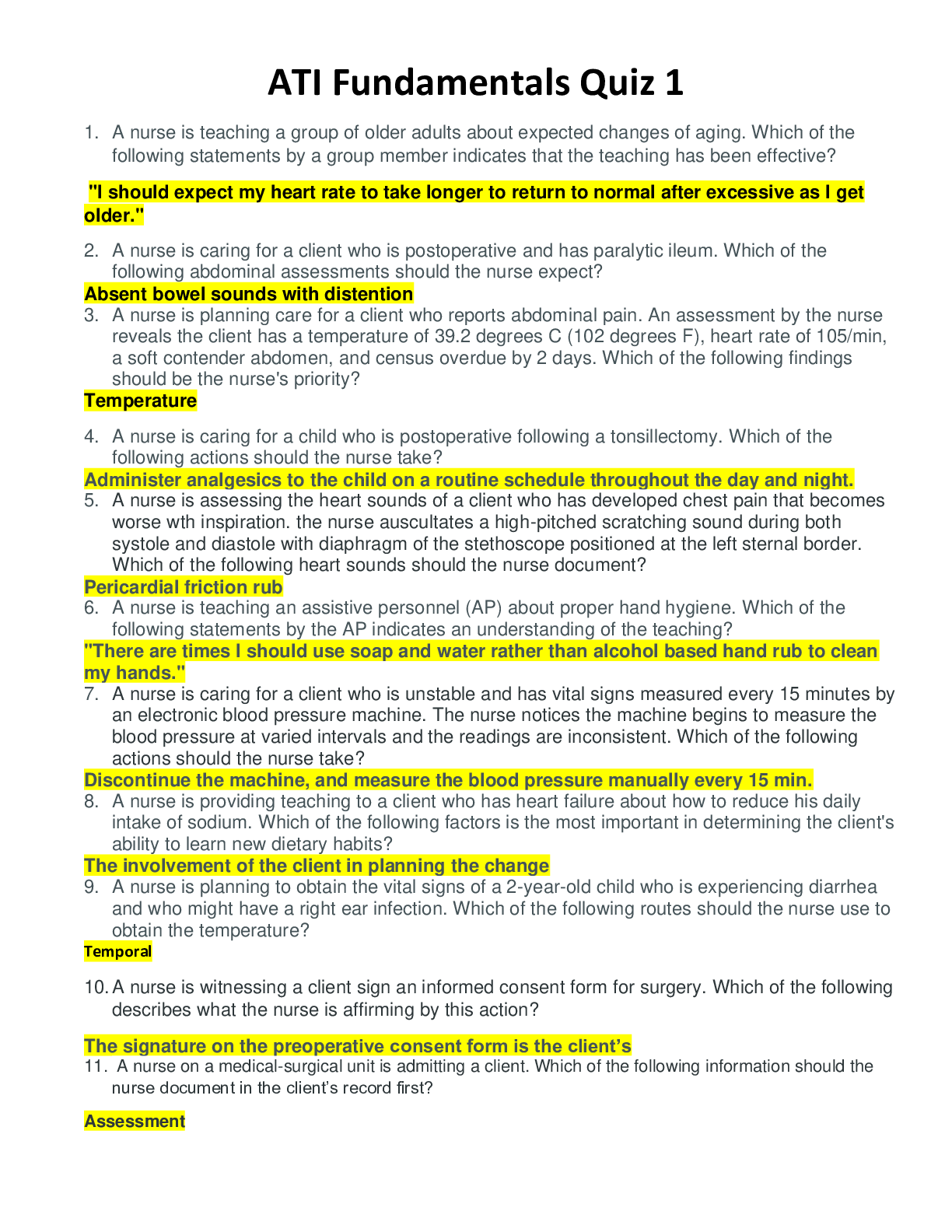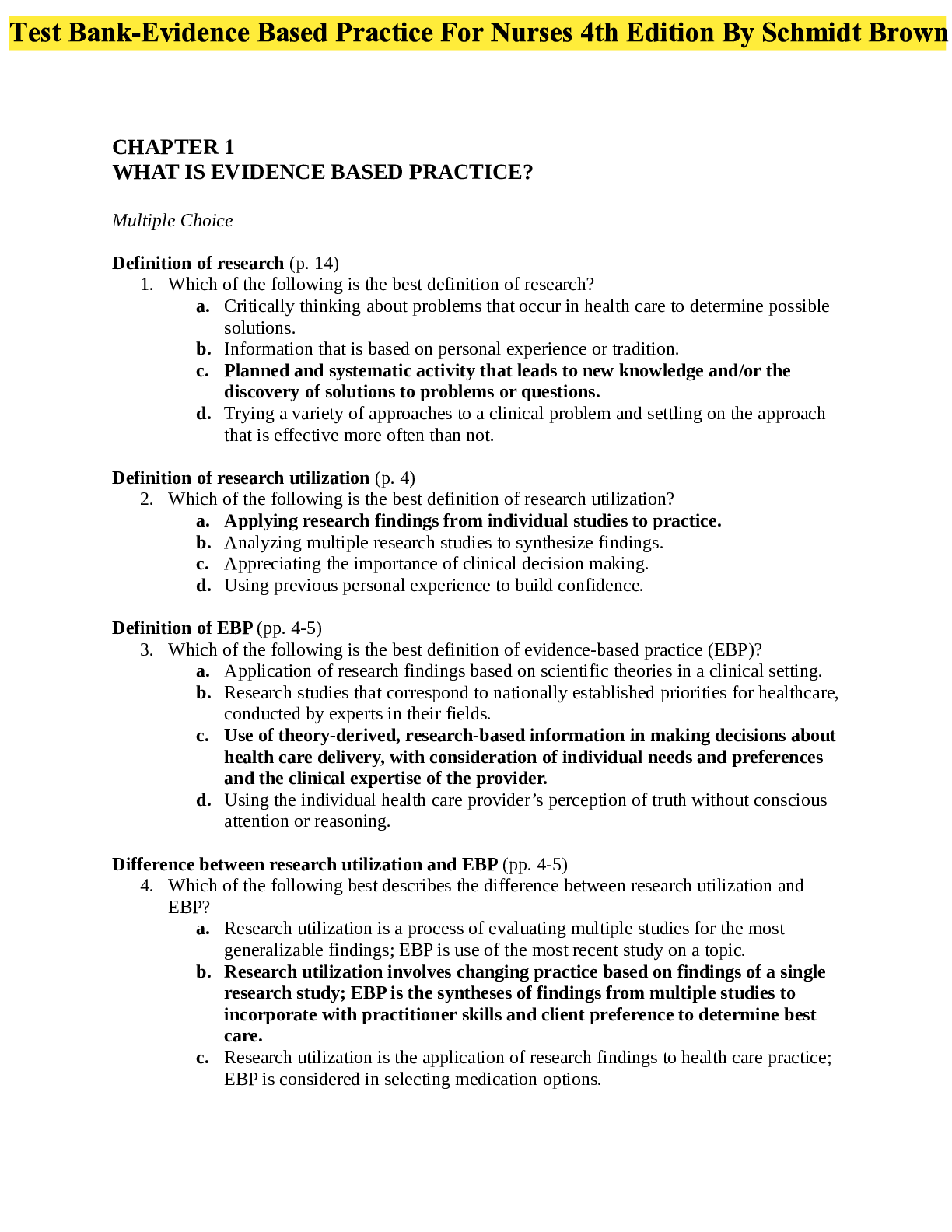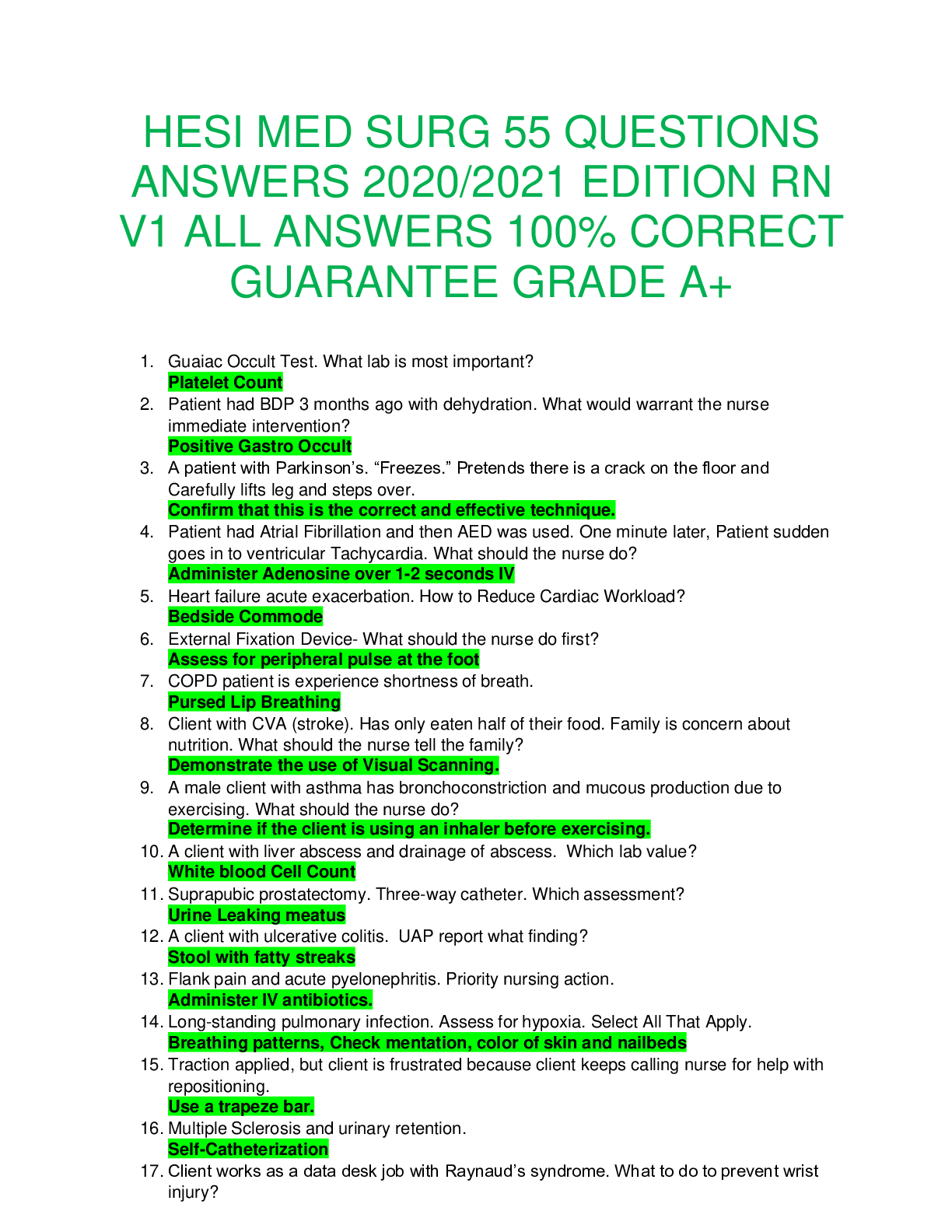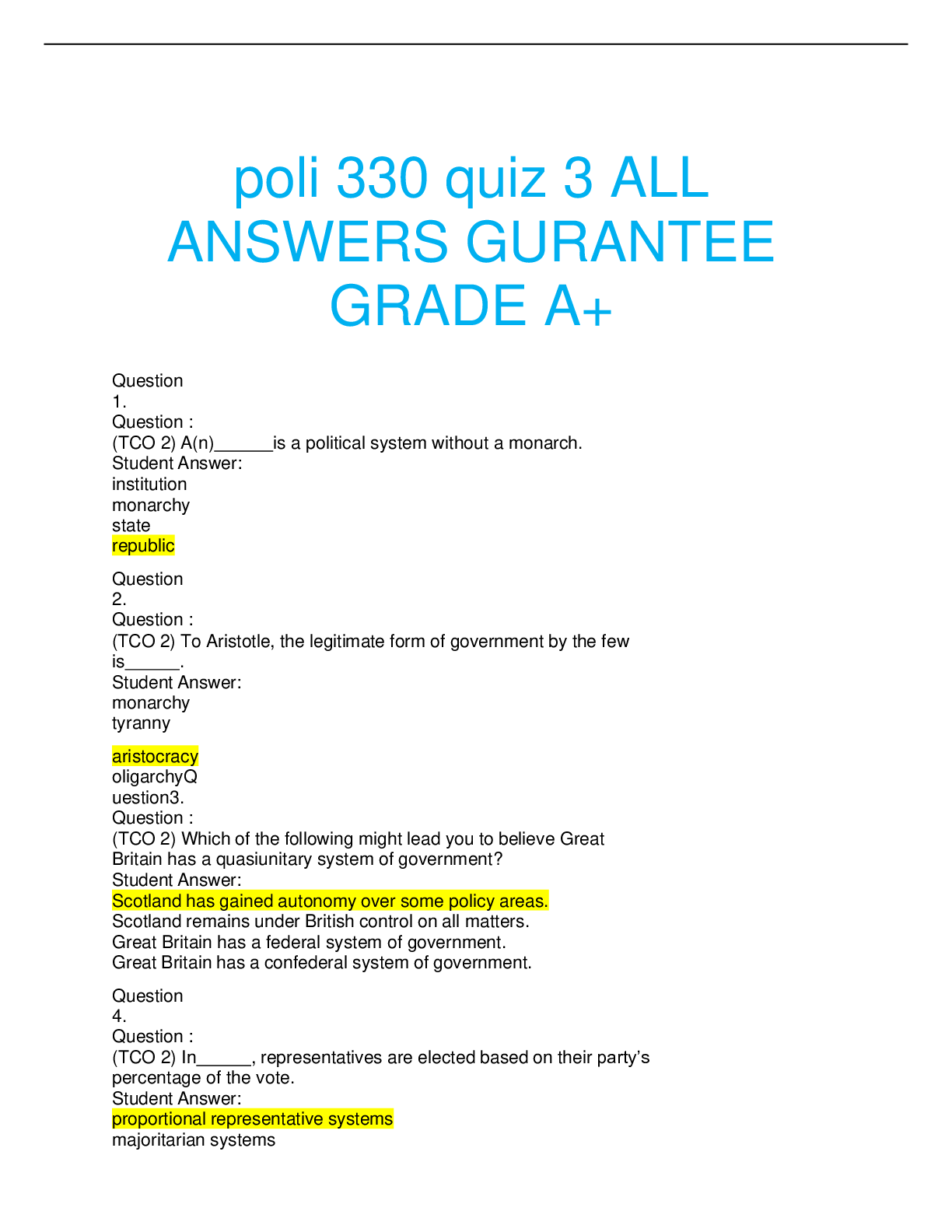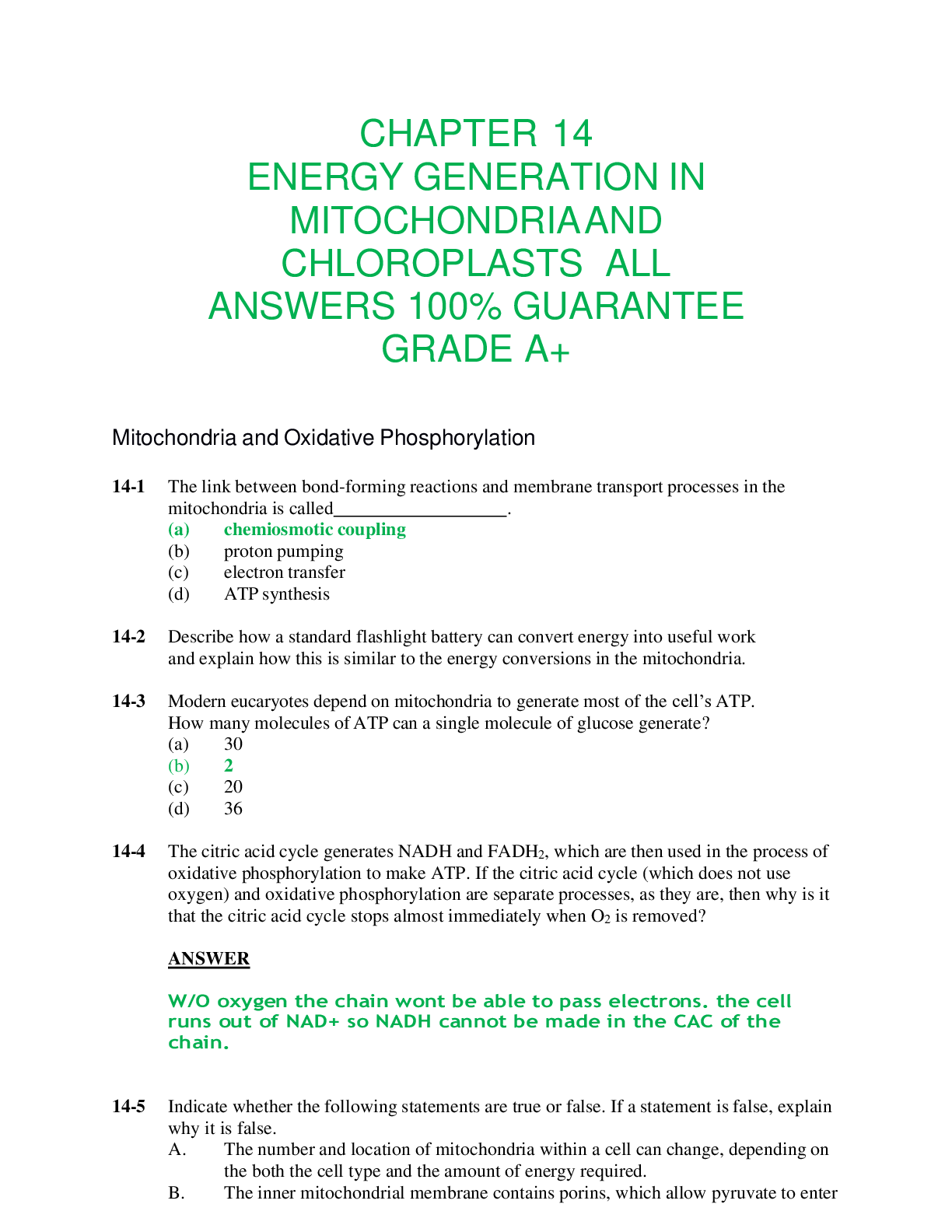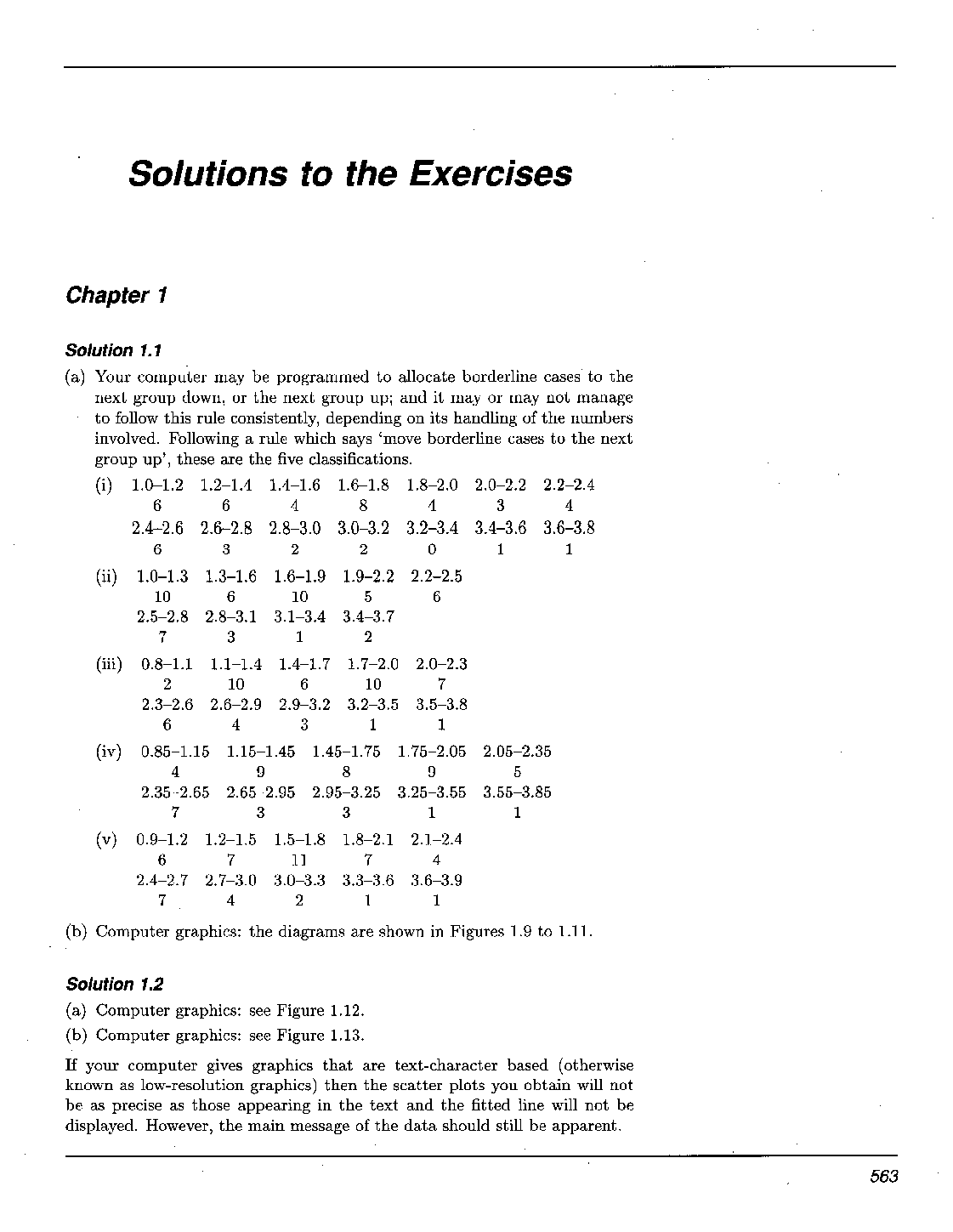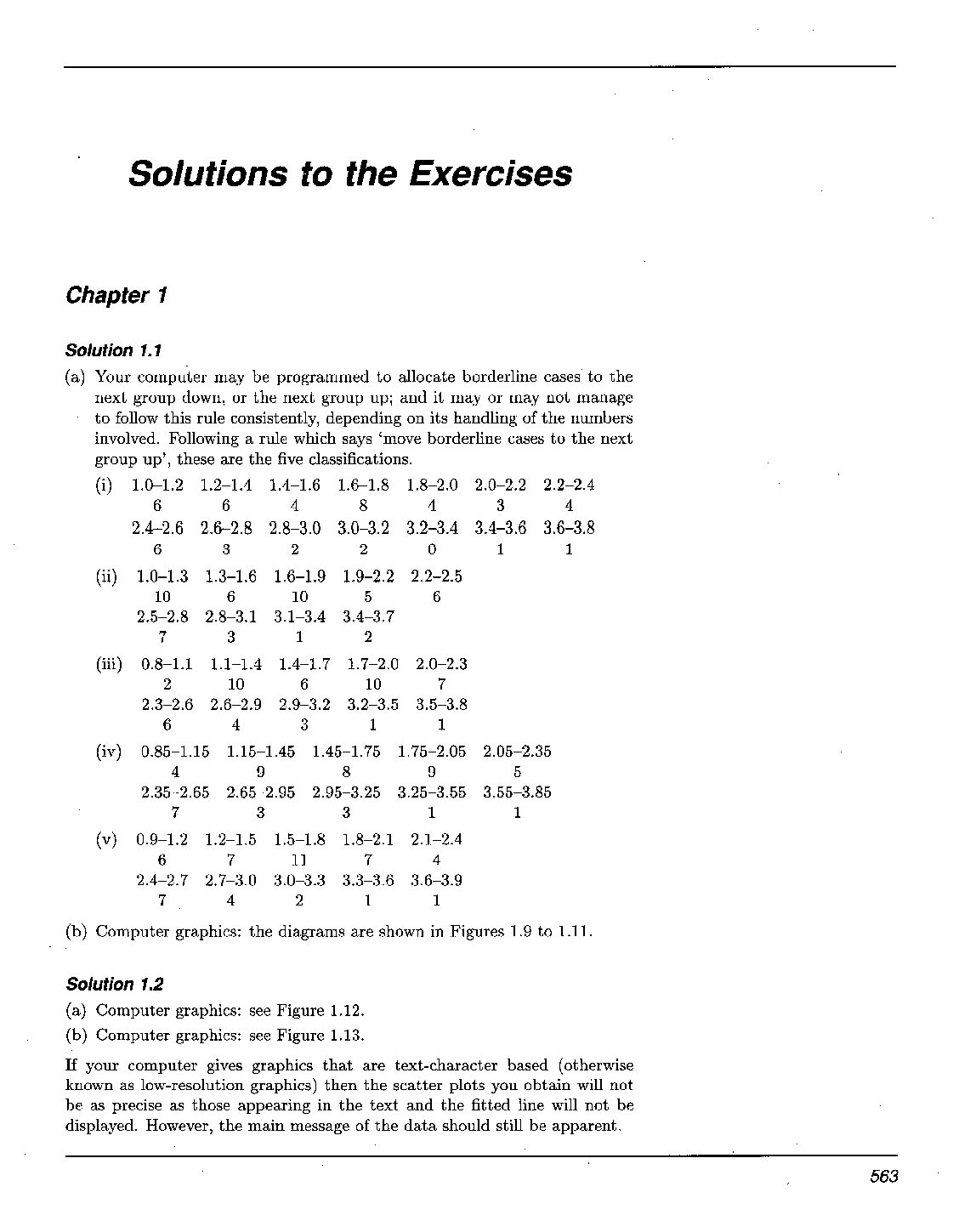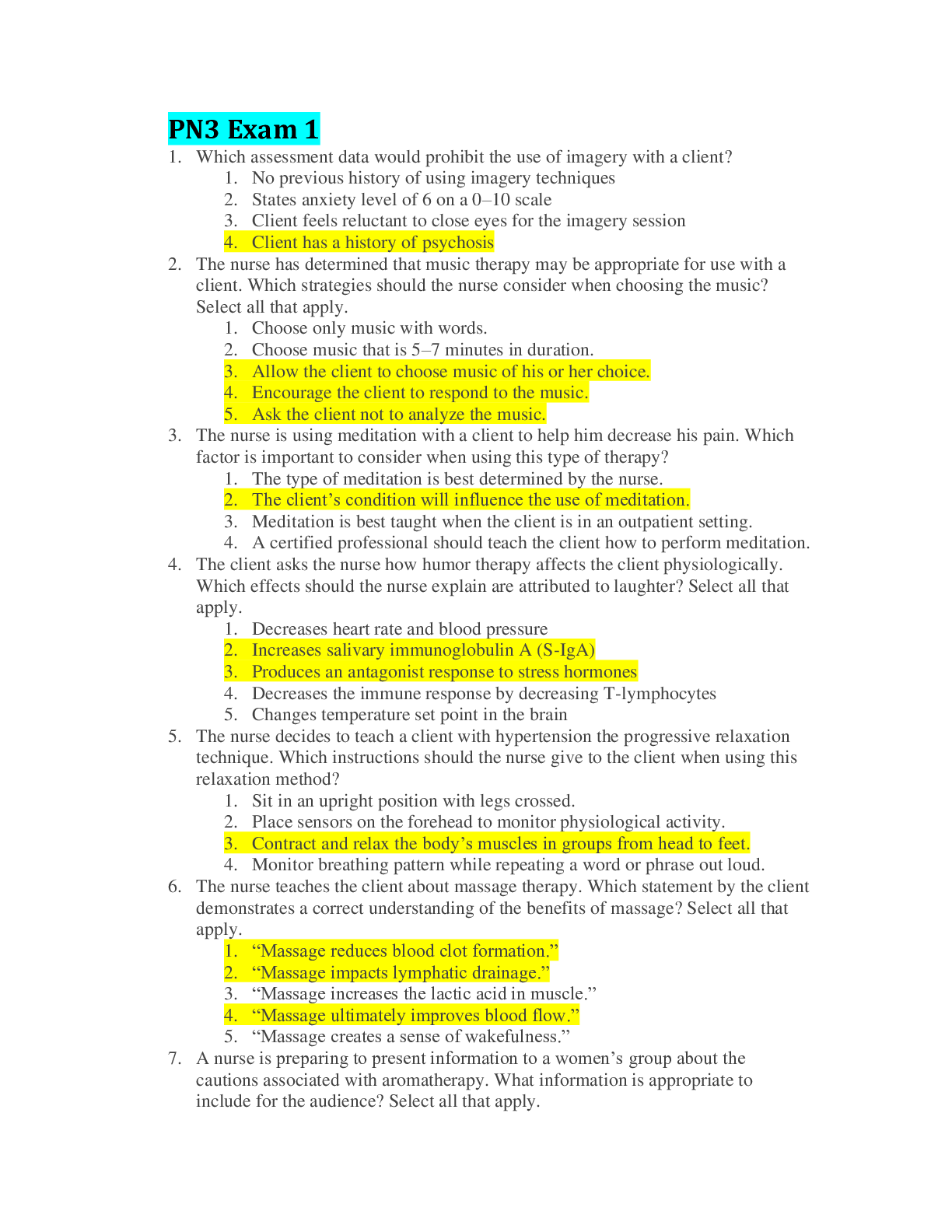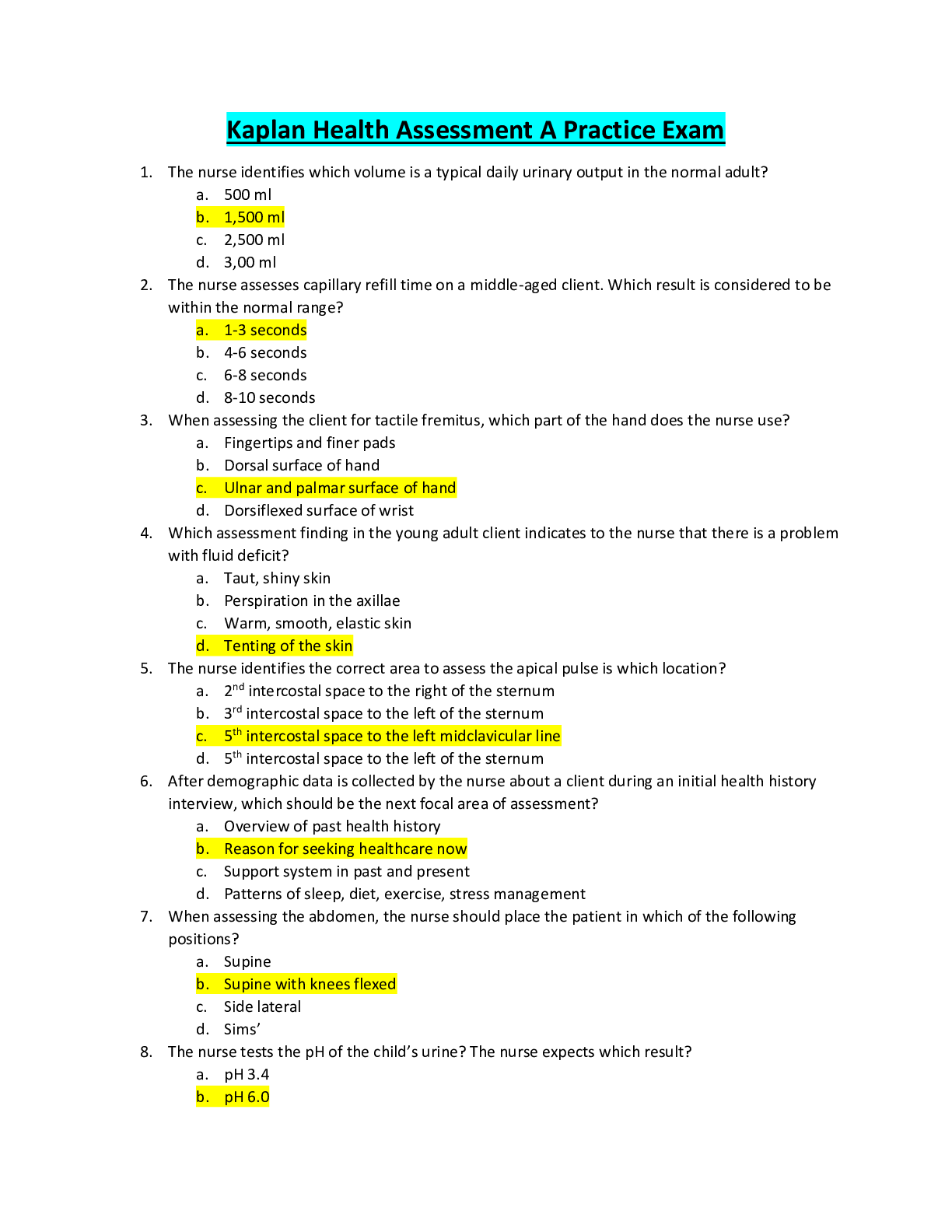*NURSING > QUESTIONS & ANSWERS > Critical Care Nursing Ch 13 All answers 100% correct aid grade ‘A’ (All)
Critical Care Nursing Ch 13 All answers 100% correct aid grade ‘A’
Document Content and Description Below
1. The nurse admits a patient to the critical care unit following a motorcycle crash. Assessment findings by the nurse include blood pressure 100/50 mm Hg, heart rate 58 beats/min, respiratory rate 30... breaths/min, and temperature of 100.5°. The patient is lethargic, responds to voice but falls asleep readily when not stimulated. Which nursing action is most important to include in this patient’s plan of care? 2. A patient with a head injury has an intracranial pressure (ICP) of 18 mm Hg. Her blood pressure is 144/90 mm Hg, and her mean arterial pressure (MAP) is 108 mm Hg. What is the cerebral perfusion pressure (CPP)? 3. While caring for a patient with a traumatic brain injury, the nurse assesses an ICP of 20 mm Hg and a CPP of 85 mm Hg. What is the best interpretation by the nurse? 4. The nurse is caring for a mechanically ventilated patient with a sustained ICP of 18 mm Hg. The nurse needs to perform an hourly neurological assessment, suction the endotracheal tube, perform oral hygiene care, and reposition the patient to the left side. What is the best action by the nurse? 5. While caring for a patient with a basilar skull fracture, the nurse assesses clear drainage from the patient’s left naris. What is the best nursing action? 6. The nurse is caring for a patient who was hit on the head with a hammer. The patient was unconscious at the scene briefly but is now conscious upon arrival at the emergency department (ED) with a GCS score of 15. One hour later, the nurse assesses a GCS score of 3. What is the priority nursing action? 7. The nurse is caring for a patient with an ICP of 18 mm Hg and a GCS score of 3. Following the administration of mannitol (Osmitrol), which assessment finding by the nurse requires further action? 8. The nurse is caring for a mechanically ventilated patient with a brain injury. Arterial blood gas values indicate a PaCO2 of 60 mm Hg. The nurse understands this value to have which effect on cerebral blood flow? 9. The nurse assesses a patient with a skull fracture to have a Glasgow Coma Scale score of 3. Additional vital signs assessed by the nurse include blood pressure 100/70 mm Hg, heart rate 55 beats/min, respiratory rate 10 breaths/min, oxygen saturation (SpO2) 94% on oxygen at 3 L per nasal cannula. What is the priority nursing action? 10. The nurse is caring for a patient who has a diminished level of consciousness and who is mechanically ventilated. While performing endotracheal suctioning, the patient reaches up in an attempt to grab the suction catheter. What is the best interpretation by the nurse? 11. The nurse is caring for a patient admitted to the ED following a fall from a 10-foot ladder. Upon admission, the nurse assesses the patient to be awake, alert, and moving all four extremities. The nurse also notes bruising behind the left ear and straw-colored drainage from the left nare. What is the most appropriate nursing action? 12. While caring for a patient with a closed head injury, the nurse assesses the patient to be alert with a blood pressure 130/90 mm Hg, heart rate 60 beats/min, respirations 18 breaths/min, and a temperature of 102° F. To reduce the risk of increased intracranial pressure (ICP) in this patient, what is (are) the priority nursing action(s)? 13. The nurse responds to a high heart rate alarm for a patient in the neurological intensive care unit. The nurse arrives to find the patient sitting in a chair experiencing a tonic-clonic seizure. What is the best nursing action? 14. The nurse is caring for a mechanically ventilated patient admitted with a traumatic brain injury. Which arterial blood gas value assessed by the nurse indicates optimal gas exchange for a patient with this type of injury? 15. The nurse is caring for a patient from a rehabilitation center with a preexisting complete cervical spine injury who is complaining of a severe headache. The nurse assesses a blood pressure of 180/90 mm Hg, heart rate 60 beats/min, respirations 24 breaths/min, and 50 mL of urine via indwelling urinary catheter for the past 4 hours. What is the best action by the nurse? 16. The nurse admits a patient to the emergency department with new onset of slurred speech and right-sided weakness. What is the priority nursing action? 17. Which patient being cared for in the emergency department should the charge nurse evaluate first? 18. The nurse admits a patient to the emergency department (ED) with a suspected cervical spine injury. What is the priority nursing action? 19. The nurse is caring for a patient 3 days following a complete cervical spine injury at the C3 level. The patient is in spinal shock. Following emergent intubation and mechanical ventilation, what is the priority nursing action? 20. The physician has opted to treat a patient with a complete spinal cord injury with glucocorticoids. The physician orders 30 mg/kg over 15 minutes followed in 45 minutes with an infusion of 5.4 mg/kg/min for 23 hours. What is the total 24-hour dose for the 70-kg patient? 21. The nurse receives a patient from the emergency department following a closed head injury. After insertion of an ventriculostomy, the nurse assesses the following vital signs: blood pressure 100/60 mm Hg, heart rate 52 beats/min, respiratory rate 24 breaths/min, oxygen saturation (SpO2) 97% on supplemental oxygen at 45% via Venturi mask, Glasgow Coma Scale score of 4, and intracranial pressure (ICP) of 18 mm Hg. Which physician order should the nurse institute first? 22. The nurse is caring for a patient 5 days following clipping of an anterior communicating artery aneurysm for a subarachnoid hemorrhage. The nurse assesses the patient to be more lethargic than the previous hour with a blood pressure 95/50 mm Hg, heart rate 110 beats/min, respiratory rate 20 breaths/min, oxygen saturation (SpO2) 95% on 3 L/min oxygen via nasal cannula, and a temperature of 101.5° F. Which physician order should the nurse institute first? 23. The nurse, caring for a patient following a subarachnoid hemorrhage, begins a nicardipine (Cardene) infusion. Baseline blood pressure assessed by the nurse is 170/100 mm Hg. Five minutes after beginning the infusion at 5 mg/hr, the nurse assesses the patient’s blood pressure to be 160/90 mm Hg. What is the best action by the nurse? 24. The nurse is preparing to administer a routine dose of phenytoin (Dilantin). The physician orders phenytoin (Dilantin) 500 mg intravenous every 6 hours. What is the best action by the nurse? 25. The nurse is caring for a patient admitted to the emergency department in status epilepticus. Vital signs assessed by the nurse include blood pressure 160/100 mm Hg, heart rate 145 beats/min, respiratory rate 36 breaths/min, oxygen saturation (SpO2) 96% on 100% supplemental oxygen by non-rebreather mask. After establishing an intravenous (IV) line, which order by the physician should the nurse implement first? 26. The physician orders fosphenytoin (Cerebyx), 1.5 g intravenous (IV) loading dose for a 75-kg patient in status epilepticus. What is the most important action by the nurse? 27. The nurse is to administer 100 mg phenytoin (Dilantin) intravenous (IV). Vital signs assessed by the nurse include blood pressure 90/60 mm Hg, heart rate 52 beats/min, respiratory rate 18 breaths/min, and oxygen saturation (SpO2) 99% on supplemental oxygen at 3 L/min by cannula. To prevent complications, what is the best action by the nurse? 28. The nurse is preparing to administer 100 mg of phenytoin (Dilantin) to a patient in status epilepticus. To prevent patient complications, what is the best action by the nurse? 29. The nurse is caring for a patient admitted with a subarachnoid hemorrhage following surgical repair of the aneurysm. Assessment by the nurse notes blood pressure 90/60 mm Hg, heart rate 115 beats/min, respiratory rate 28 breaths/min, oxygen saturation (SpO2) 99% on supplemental oxygen at 3L/min by cannula, a Glasgow Coma Score of 4, and a central venous pressure (CVP) of 2 mm Hg. After reviewing the physician orders, which order is of the highest priority? 30. After receiving the hand-off report from the day shift charge nurse, which patient should the evening charge nurse assess first? 31. The nurse has just received a patient from the emergency department with an admitting diagnosis of bacterial meningitis. To prevent the spread of nosocomial infections to other patients, what is the best action by the nurse? 32. The nurse is caring for a patient admitted with bacterial meningitis. Vital signs assessed by the nurse include blood pressure 110/70 mm Hg, heart rate 110 beats/min, respiratory rate 30 breaths/min, oxygen saturation (SpO2) 95% on supplemental oxygen at 3 L/min, and a temperature 103.5° F. What is the priority nursing action? [Show More]
Last updated: 1 year ago
Preview 1 out of 15 pages

Buy this document to get the full access instantly
Instant Download Access after purchase
Add to cartInstant download
We Accept:

Reviews( 0 )
$25.00
Document information
Connected school, study & course
About the document
Uploaded On
Mar 23, 2021
Number of pages
15
Written in
Additional information
This document has been written for:
Uploaded
Mar 23, 2021
Downloads
0
Views
132

